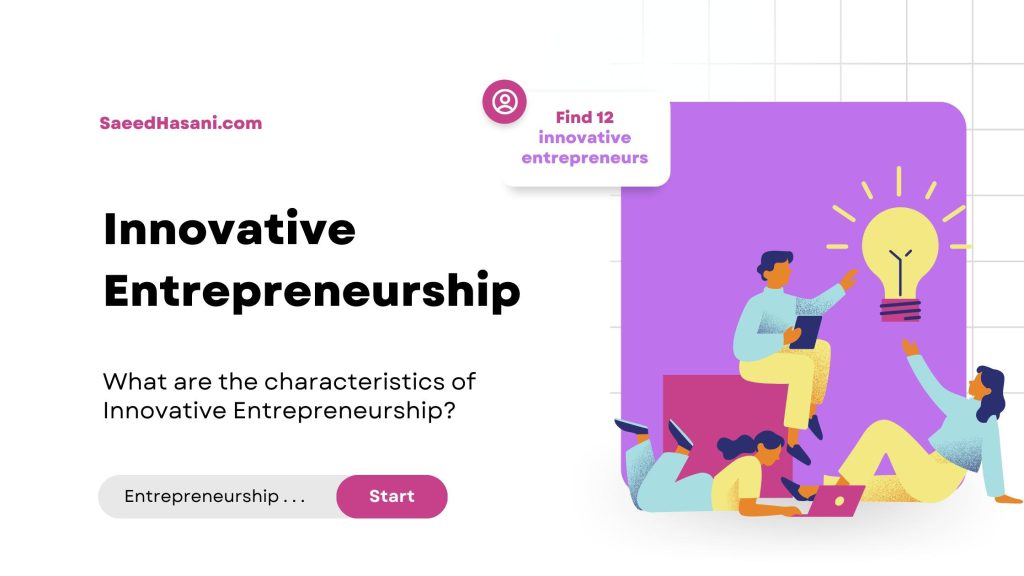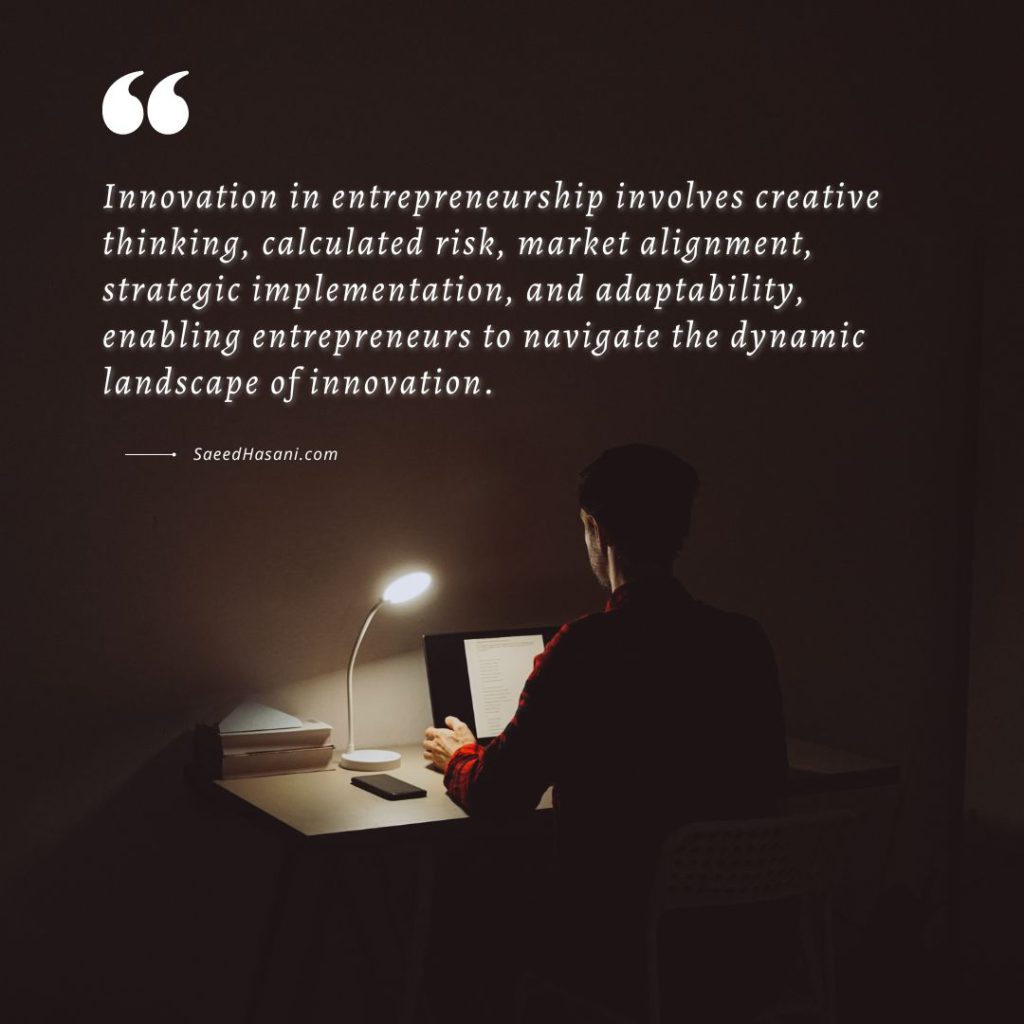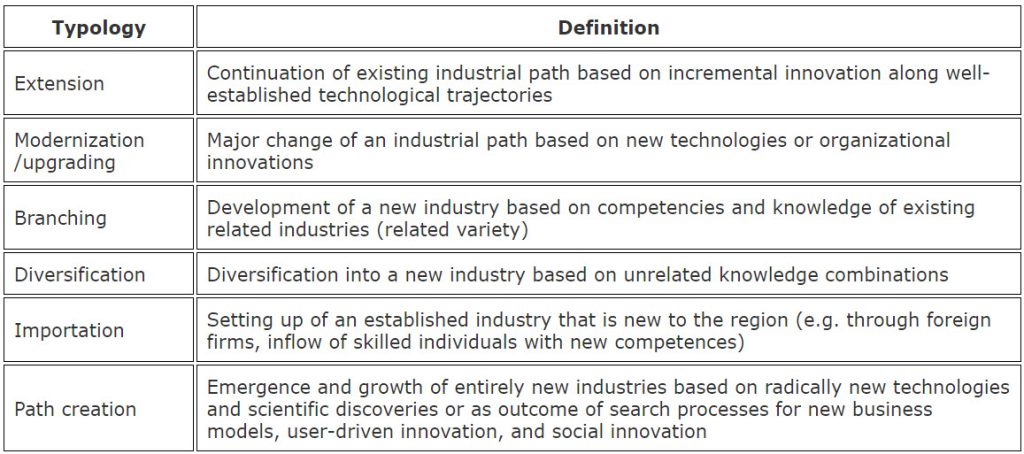Innovative Entrepreneurship | 11+1 examples of innovative entrepreneurs

Innovation is the driving force behind groundbreaking change and value in the market and society. It’s about bringing fresh ideas, products, services, or business models to life, addressing unmet needs, and seizing opportunities creatively. We would like to provide you with helpful information about Innovative Entrepreneurship.
Content Overview:
What is innovative entrepreneurship?
Innovations come in various forms, from technological advancements to strategic marketing and organizational transformations.
At the core of innovation in entrepreneurship lie several key elements:
Creativity: begins with sparking original and imaginative ideas capable of solving existing problems or fulfilling emerging demands.
Innovative entrepreneurs possess a creative solid mindset, allowing them to think beyond conventions and generate original and imaginative ideas that challenge norms.
Risk-taking: Entrepreneurs are no strangers to taking calculated risks to pursue innovative visions. They invest time, resources, and effort, fully aware that success is not guaranteed.
Market Opportunity: Successful innovations must align with real market needs, offering significant improvements over existing solutions.
Implementation: The journey from idea to reality involves effective planning, execution, and continuous innovation refinement. Successfully bringing an innovation to market requires meticulous planning, resource allocation, and effective execution. Resourceful Implementation and all necessary measures will achieve the goals of Innovative Entrepreneurship.
Adaptability: In a fast-paced business landscape, adaptability is critical for entrepreneurs to stay relevant amid changing markets, evolving customer preferences, and technological advances. The path of entrepreneurship is full of uncertainty and challenges. Innovators thrive by being open to feedback and making necessary adjustments.
They remain flexible and adaptable to changing market conditions and unexpected obstacles. A willingness to pivot and adjust strategies is critical to effectively managing uncertainty. Innovative entrepreneurs quickly adapt to new technologies, market changes, and customer preferences.
The business landscape is dynamic and innovative entrepreneurs are flexible to changing conditions. They base their ideas on market feedback and new information. Adaptability is essential for entrepreneurs who are interested in innovative entrepreneurship.
Scalability: Lasting impact comes with scaling innovations and reaching broader audiences.
Innovation is pivotal in propelling economic growth, elevating living standards, and tackling societal issues. For these reasons, an important issue such as Innovative Entrepreneurship is considered.
For aspiring entrepreneurs, embracing innovation is not just an option but a fundamental aspect of achieving success. Identifying opportunities for innovation and effectively bringing these revolutionary ideas to fruition can pave the way for a thriving entrepreneurial journey.

When considering innovations and entrepreneurship?
When dealing with the world of innovations and entrepreneurship, understanding the pivotal role of innovation in driving entrepreneurial success becomes very important.
Here are some key considerations that make Innovative Entrepreneurship a reality:
Spotting Opportunities: Innovation entails identifying market gaps, unmet needs, or emerging trends that pave the way for new products, services, or business models.
Thorough Market Research: Before embarking on an innovative venture, entrepreneurs should conduct comprehensive market research to gauge their ideas’ feasibility and potential demand.
They conduct comprehensive market research to comprehend industry trends, customer needs, and pain points. By analyzing data and gaining insights, they discover unmet demands and gaps in the market.
Nurturing Creativity and Ideation: Cultivating a creative mindset and encouraging imagination are essential for generating distinct and original concepts that set a business apart.
Testing and feedback: Entrepreneurs should adopt a culture of testing their innovations through minimum viable products (MVPs) and actively seek feedback to refine their ideas before full-scale rollout. They seek feedback from their clients, mentors, and peers. Constructive criticism helps refine and improve their ideas. Paying attention to feedback is essential for the realization of innovative entrepreneurship.
Safeguarding Intellectual Property: Protecting intellectual property through patents, copyrights, or trademarks is crucial to prevent imitation and maintain a unique position in the market.
Leveraging Collaboration and Partnerships: Collaborating with like-minded individuals, research institutions, or established companies can accelerate innovation and broaden market reach.
Ethical Considerations: Innovators must carefully consider the ethical implications of their products or services to ensure alignment with societal values and norms.
Scalability and Sustainability: Entrepreneurs should plan for the scalability of their innovations to meet growing demands while ensuring long-term sustainability.
Customer-Centric Approach: Successful innovation involves understanding and addressing customer needs, placing customer satisfaction at the core of entrepreneurial endeavors.
Impacting society Positively: Entrepreneurs should be mindful of the broader impact their innovations have on society, including environmental, social, and economic implications.
Entrepreneurs can make a profound and enduring impact through their innovative ventures by adopting a customer-centric outlook, managing risks, and maintaining a thirst for learning.
What types of innovations can entrepreneurs use?
Entrepreneurs can utilize a range of innovation types to drive growth, enter new markets, or redefine existing ones. Here are the types of innovations that can be leveraged:
- Extension: This type of innovation involves incremental changes and improvements to existing products, services, or processes. Entrepreneurs can use extension innovation to refine the current offerings incrementally, making them more efficient or suitable to changing customer needs. This could involve adding new features to a product or enhancing service to maintain a competitive advantage without deviating from the established industrial path.
- Modernization / Upgrading: Here, more significant changes are implemented, often using new technologies or organizational innovations. Entrepreneurs may adopt cutting-edge technology or new business methodologies to overhaul current practices, potentially transforming an established industry. This offers the advantage of staying within a familiar domain while significantly improving or changing the operational and value delivery aspects of the industry.
- Branching: This innovation exploits the knowledge and competencies from one industry to spawn a new branch or sector. Entrepreneurs can identify synergies in their current understanding and operational framework to explore adjacent markets. For example, a company manufacturing lenses for glasses might venture into the production of camera lenses or telescope optics.
- Diversification: This type of innovation involves stepping into a completely new industry that does not relate to the current knowledge base. Diversification requires an entrepreneurial leap, where new skills and knowledge are combined to create a separate line of products or services. For example, a tech entrepreneur might diversify into producing health food products, leveraging business acumen without relying on previous industry-specific knowledge.
- Importation: Entrepreneurs can also innovate by importing established industries into new regions. This could be through launching a franchise from a foreign firm or attracting skilled individuals with new competencies to a particular area. This not only brings new industry to a region but can also drive innovation within the local market by introducing new competencies and ideas.
- Path Creation: This represents the most radical form of innovation, where entrepreneurs are involved in creating entirely new industries. Such industries might arise from groundbreaking technologies, scientific discoveries, or a profound understanding of emerging business models, user-driven innovation, and social innovation. This is the most uncertain type of innovation but potentially the most rewarding, as it can establish the entrepreneur as a pioneer in a completely novel market.
Entrepreneurs must carefully consider their strengths, market understanding, and resources when deciding which type of innovation to pursue. Each type requires different approaches and entails varying levels of risk and potential reward .

How does an innovative entrepreneur contribute to the business landscape?
An innovative entrepreneur can profoundly impact the business landscape through various means. Here are some key ways to make Innovative Entrepreneurship a reality.
Discovering Untapped Markets
Innovative entrepreneurs spot untapped markets, unmet needs, or emerging trends, developing unique products and services that disrupt traditional industries and create new markets.
Pioneering Technological Advancements
At the forefront of technology, these entrepreneurs pioneer cutting-edge innovations that revolutionize industries, boost efficiency, and elevate product and service quality.
Fueling Economic Growth and Job Creation
Successful innovative ventures drive economic growth by generating employment opportunities and stimulating economic activity. They contribute to GDP growth and foster a culture of entrepreneurship, inspiring others to start their businesses.
Gaining Competitive Edge
Businesses led by innovative entrepreneurs gain a competitive advantage over rivals with distinctive offerings that attract customers, leading to increased market share and profitability. Innovations set entrepreneurs apart, drawing in customers and creating a distinctive edge.
While innovations can provide a competitive edge, entrepreneurs must also be mindful of potential competitors and strategize to differentiate their offerings effectively.
Improving Lives
Some innovative entrepreneurs focus on addressing societal challenges, enhancing the quality of life in healthcare, education, sustainability, and more.
Attracting Investment
Their promising ideas attract investment from venture capitalists, angel investors, or government grants, enabling them to expand and grow their operations.
Catalyzing Creativity and Change
Innovative entrepreneurs inspire others to embrace innovation and take creative risks. Their success stories motivate aspiring entrepreneurs to pursue their groundbreaking ideas.
Reaching a Global Audience
Innovative entrepreneurs can rapidly scale their businesses and reach a global audience, influencing markets and societies beyond geographical boundaries.
Driving Industry Evolution
Challenging norms and pushing industries to evolve forces existing companies to adapt and innovate to remain competitive.
Building Collaborative Ecosystems
Successful innovative entrepreneurs collaborate with startups, established companies, research institutions, and government bodies, contributing to robust innovation ecosystems that foster growth and cooperation.
Becoming Role Models
As role models for aspiring entrepreneurs, they exemplify how transformative ideas can lead to business success and positive change, especially in emerging fields like technology and sustainability.
Promoting Sustainable Practices
Some innovative entrepreneurs prioritize sustainability and environmental responsibility, introducing eco-friendly products or implementing sustainable business practices that contribute to a greener and more responsible business landscape.
In conclusion, innovative entrepreneurs are pivotal in shaping the business landscape. Their novel ideas, technological advancements, and customer-centric approaches drive economic growth, create jobs, improve lives, and propel industries into the future. Their contributions are vital for progress and advancement in various sectors, catalyzing positive change in the global economy.
What are the key characteristics of an innovative entrepreneur?
The characteristics of an innovative entrepreneur play a fundamental role in creating and better implementing groundbreaking ideas. These traits empower them to navigate the challenges of entrepreneurship and profoundly impact the business landscape. Here are the key characteristics of an innovative entrepreneur:
Visionary Thinking
They have a clear vision of the future and are keen to identify emerging trends and opportunities within the market.
Problem-Solving Skills
Natural problem solvers, innovative entrepreneurs see challenges as opportunities and tackle them with determination and resourcefulness.
Risk-Taking
Unafraid of uncertainty, they embrace calculated risks and view failures as stepping stones toward eventual success. Understanding that venturing into new opportunities involves risks, they take calculated steps, acknowledging that failure is a natural part of the innovation process.
They conduct meticulous risk assessments for their novel ideas or projects. That involves identifying potential risks, evaluating their impact, and devising mitigation strategies.
As innovation carries inherent uncertainty, entrepreneurs must be willing to take calculated risks when developing and implementing their groundbreaking ideas.
Resilience
Innovation often involves facing setbacks and obstacles. Innovative entrepreneur exhibits resilience, maintaining focus on their goals despite challenges.
Openness to Learning
Driven by a thirst for knowledge, they remain open to learning from various sources, whether through formal education, mentorship, or self-study.
Customer-Centric Focus
Understanding the significance of meeting customer needs, they continuously seek feedback to enhance their products or services.
Entrepreneurial Spirit
Driven by an entrepreneurial spirit, they are proactive and resourceful and seize opportunities to create value.
Passion
Fueled by deep passion, they are resolute in bringing their ideas to fruition and are motivated by a sense of purpose.
Collaboration
Open to collaboration, innovative entrepreneurs build diverse networks, engage with like-minded individuals, and form partnerships to strengthen their ideas and broaden their reach.
Long-Term Vision
While focused on immediate success, they also harbor a long-term vision for the sustainable growth of their venture.
Resource Management
Understanding the importance of effective resource management, they optimize their innovation process by judiciously allocating time, finances, and talent.
Ethical Conduct
Mindful of ethical implications, they ensure their innovations align with societal values and demonstrate responsibility towards the environment and stakeholders.
Innovation Ecosystem Awareness
They are well-versed in the broader innovation ecosystem, including research institutions, industry trends, and government regulations, influencing their entrepreneurial journey.
Innovative entrepreneurs possess a distinctive blend of creativity, resilience, adaptability, and passion. These defining characteristics empower them to envision a brighter future, bring novel ideas to life, and significantly impact the business landscape and society.
What are some examples of innovative entrepreneurs?
In entrepreneurship, numerous examples of innovative individuals have left a profound impact on various industries and reshaped the business landscape. Let’s take a look at some renowned examples:
- Elon Musk: Known for his trailblazing ideas in electric vehicles, and space exploration, Elon Musk is the founder and CEO of Tesla and SpaceX, Neuralink, the Boring Company, and renewable energy.
- Steve Jobs: A visionary entrepreneur and co-founder of Apple Inc., Steve Jobs has revolutionized the technology industry by producing and introducing iconic products such as the iPhone, iPad and MacBook, surprising many people. He is one of the most influential people who works in the field of innovative entrepreneurship.
- Jeff Bezos: Founder and former CEO of Amazon. He changed the way we shop and provided innovative services, the most famous of which are: Amazon Prime and Amazon Web Services (AWS).
- Sara Blakely: Founder of Spanx, Sara Blakely disrupted the undergarment industry with her innovative shapewear products, earning her place as one of the youngest self-made female billionaires.
- Mark Zuckerberg: He is one of the most influential people working in innovative entrepreneurship. Co-founder and CEO of Facebook, Mark Zuckerberg revolutionized social media and communication by creating the world’s largest social networking platform.
- Richard Branson: He is often praised for his adventurous and diverse business ventures in music, airlines, and space tourism. The founder of Virgin Group was Richard Branson.
- Larry Page and Sergey Brin: They are Co-founders of Google. Larry Page and Sergey Brin transformed internet search and digital advertising, establishing one of the most influential technology companies worldwide.
- Arianna Huffington: she is the founder of The Huffington Post. Arianna Huffington disrupted traditional media by creating an influential online news platform emphasizing user-generated content and opinion.
- Brian Chesky, Joe Gebbia, and Nathan Blecharczyk: Co-founders of Airbnb, these entrepreneurs revolutionized the hospitality industry with a platform allowing individuals to rent out their homes, redefining how people travel and experience accommodation.
- Travis Kalanick and Garrett Camp: Co-founders of Uber, Travis Kalanick and Garrett Camp, transformed the transportation industry with their innovative ride-hailing service, providing an alternative to traditional taxis.
- Reed Hastings: As the co-founder and CEO of Netflix, Reed Hastings transformed the entertainment industry by introducing online streaming, fundamentally changing how people consume movies and TV shows.
- Brian Acton and Jan Koum: Co-founders of WhatsApp, Brian Acton, and Jan Koum, revolutionized mobile messaging by creating a simple, secure, and free messaging platform used globally.
These visionary entrepreneurs have achieved remarkable business success and have made a lasting impact on society, reshaping how we live, work, and interact with technology and each other. Their innovative spirit continues to inspire and influence the entrepreneurial landscape, leaving a legacy that shapes the future of business.
How do innovative entrepreneurs identify and exploit opportunities?
Innovative entrepreneurs possess valuable skills and approaches that empower them to spot opportunities and revolutionize the market with fresh ideas. Here are some essential strategies they employ:
- Cultivating curiosity and observation: Entrepreneurs interested in innovative entrepreneurship maintain a curious mindset and intensely observe their surroundings. They stay in tune with emerging trends, technological advancements, and changing consumer behavior.
- Problem-solving Prowess: They have an inherent drive to solve problems. Instead of avoiding challenges, they actively seek them as opportunities to develop innovative solutions.
- Network and Collaborate: Building a diverse network of contacts provides them with different perspectives and expertise. Collaboration with like-minded individuals, industry experts, and potential customers opens new opportunities.
- Lifelong Learning: Innovative entrepreneurs constantly invest time and effort in staying updated with the latest developments in their field and beyond, expanding their knowledge base.
- Experimentation and Prototyping: Fearless in their pursuit, they experiment and prototype their ideas. Through testing and feedback, they refine their innovations before fully committing resources.
- Follow Passion and Purpose: Their work is often driven by a passion for solving specific problems or addressing societal needs. Aligning their efforts with a clear purpose keeps them focused and motivated.
- Harness Technology: Technology acts as a catalyst for innovation. Innovative entrepreneurs leverage it to streamline processes, create new products, and reach broader markets.
- Cross-Industry Insights: They draw inspiration from unrelated industries and fields. Applying knowledge from different domains leads to breakthrough ideas and unique perspectives.
- Customer-Centric Approach: Customers are at the core of their innovation process. Understanding their needs and preferences helps them develop solutions that address real problems.
- Adaptability: The business landscape is dynamic, and innovative entrepreneurs remain flexible to changing circumstances. They pivot their ideas based on market feedback and new information. For entrepreneurs who are interested in innovative entrepreneurship, Adaptability is essential to them.
- Monitor Competition: Keeping a close eye on competitors helps identify areas where they can differentiate their offerings and create a distinctive value proposition.
- Scalability Focus: Innovative entrepreneurs consider the scalability of their ideas from the outset. They aim to create solutions that can reach a broader audience and have a lasting impact.
In conclusion, innovative entrepreneurs possess unique skills, mindsets, and approaches that enable them to seize and capitalize on opportunities effectively. By nurturing curiosity, embracing risk, and prioritizing customer needs, they pave the way for groundbreaking ideas and successful ventures.
How can entrepreneurs foster a culture of innovation within their organizations?
Cultivating an organization’s innovation culture is paramount for entrepreneurs aiming to achieve continuous growth and maintain a competitive edge in today’s dynamic business landscape. To foster an environment that encourages innovation, here are some essential approaches entrepreneurs can adopt:
- Lead by Example: Entrepreneurs should exemplify their commitment to innovation by embracing change, welcoming new ideas, and taking calculated risks. Leading with an innovative spirit sets the tone for the entire organization.
- Define a Clear Vision: Effectively communicate the organization’s vision and mission to all employees. An inspiring vision provides a shared purpose, motivating employees to think creatively to pursue common goals.
- Encourage and Reward Creativity: Encourage and reward creativity: It is better always to encourage employees who provide good ideas or innovative solutions. Recognition programs, bonuses, or incentives can effectively promote and celebrate creativity. Encourage and Reward Creativity will realize innovative entrepreneurship.
- Foster a Collaborative Environment: Create opportunities for cross-functional teams to collaborate. Collaboration fosters the exchange of diverse perspectives and ideas, fueling innovation.
- Provide Resources and Support: Ensure employees can access necessary resources, including time, tools, and training, to pursue innovative projects. Supportive leadership and a risk-tolerant atmosphere are vital.
- Nurture a Growth Mindset: Encourage a growth mindset within the organization, where failure is viewed as a chance to learn and improve. Employees should be encouraged to experiment and iterate on their ideas.
- Promote Knowledge Sharing: Establish platforms for sharing knowledge and best practices among employees. Regular meetings, workshops, or digital collaboration tools can facilitate knowledge exchange.
- Celebrate Small Wins: Recognize and celebrate incremental progress and small achievements. Acknowledging efforts boosts morale and stimulates further innovation.
- Foster an Inclusive Culture: Ensure all employees feel valued and heard, regardless of their position or background. An inclusive culture fosters diverse perspectives and nurtures innovative thinking.
- Encourage Feedback and Open Communication: Create a feedback-friendly environment. Because in this situation, employees will feel more comfortable sharing their thoughts and suggestions with other employees or their managers. Open communication channels lead to valuable insights and ideas.
- Invest in Learning Opportunities: Allocate resources to continuous learning and development programs for employees. Training and workshops enhance skills and knowledge, contributing to a culture of innovation.
- Establish Innovation Challenges: Regularly organize innovation challenges or hackathons, encouraging employees to collaborate and solve specific problems or explore new opportunities.
- Measure and Track Progress: Implement metrics to evaluate innovation efforts and track progress over time. Regularly reviewing results helps identify areas for improvement.
By implementing these strategies, entrepreneurs can nurture a culture of innovation that empowers their teams to think creatively, explore novel possibilities, and drive the organization’s success in an ever-evolving business landscape.
How do innovative entrepreneurs manage risk and uncertainty?
Navigating the path of innovation can be fraught with risk and uncertainty, especially for forward-thinking entrepreneurs. Successfully managing these challenges is a critical factor in their ultimate triumph. Let’s explore some critical approaches innovative entrepreneurs employ to tackle risk and uncertainty:
- Start with Baby Steps: To realize Innovative Entrepreneurship, you should not do risky things without prior planning. Innovative entrepreneurs often begin with small-scale experiments or prototypes to test their ideas before committing substantial resources. This cautious approach allows them to gauge the feasibility of their innovations while minimizing potential losses.
- Cultivating a Growth Mindset: They foster a growth mindset within their organizations, viewing failures as invaluable learning opportunities rather than insurmountable setbacks. This outlook empowers them to adapt and refine their innovations continuously.
- Embracing Agility: By adopting an agile project management approach, innovative entrepreneurs can respond rapidly to changing circumstances and make real-time adjustments based on feedback.
- Diversification Strategy: They diversify risks by spreading their ventures across multiple projects or initiatives. This strategy helps mitigate the impact of potential failures, as one idea’s success may offset another’s setbacks.
- Commitment to Lifelong Learning: Innovative entrepreneurs dedicate themselves to ongoing learning and stay abreast of industry trends and emerging technologies. This knowledge empowers them to make well-informed and calculated decisions.
- Sound Financial Management: Effective financial management is paramount for risk management. They maintain a clear understanding of their financial standing and budget prudently to prevent overextension of resources.
- Building a Robust Network: Creating a diverse network of contacts and collaborating with experts in various fields provides valuable insights and support when confronting uncertainty.
- Validating the Market: They validate their innovations through market research, customer feedback, and pilot programs before scaling up. This validation process ensures genuine demand for their products or services.
- Scenario Planning: Innovative entrepreneurs engage in scenario planning to anticipate and prepare for various potential outcomes. They can develop contingency plans to handle unforeseen challenges by considering different scenarios.
- Challenging Assumptions: They test the assumptions underpinning their innovative ideas to ensure validity. This process of validation helps to reduce uncertainty and facilitates more informed decisions.
- Customer-centric approach: When the customer-oriented approach is considered, their solutions will effectively meet the real needs and wants. Understanding customer feedback and preferences reduces uncertainty regarding market acceptance.
- Keeping an Eye on Competitors: Monitoring the activities of the competitors makes potential threats and opportunities better identified and thus enables them to maintain their competitive advantage.
- Seeking Expert Advice: They seek counsel from mentors, industry experts, or advisors. These insights offer invaluable guidance and diverse perspectives when navigating uncertain situations.
By integrating these strategies, innovative entrepreneurs can adeptly manage risk and uncertainty, increasing their likelihood of success as they bring groundbreaking ideas to the market.
Organizational Transformations as Innovative Entrepreneurship
Organizational transformations through innovative entrepreneurship are a crucial aspect for businesses to adapt to the rapidly changing marketplace. It involves reimagining existing business models, company cultures, and management processes to foster innovation and drive growth. Businesses undertaking such transformations must focus on the following key areas:
- Cultural Shift: Embracing a culture that values creativity, risk-taking, and a proactive approach to problem-solving. This involves creating an environment where innovative ideas can thrive, without the fear of failure.
- Agile Methodologies: Implementing agile practices to enhance the speed and quality of project development. This allows for quick responses to market changes and customer feedback, ensuring the company’s offerings remain relevant.
- Customer-Centric Approach: Prioritizing the needs and preferences of the customer to guide innovation efforts. This implies a deep understanding of customer experiences and designing solutions that address their pain points.
- Leveraging Technology: Exploiting the latest technologies for improved productivity and innovation. This might involve adopting AI, machine learning, data analytics, and other digital tools to streamline processes and offer advanced solutions.
- Strategic Alliances: Forming partnerships with other businesses, startups, or academic institutions. Collaborative efforts can often lead to shared knowledge, resources, and innovative breakthroughs.
- Leadership and Management Adjustments: Leaders and managers must be equipped to navigate the company through transformation. This requires training to manage change effectively and lead innovation initiatives.
- Investing in Talent: Attracting and retaining individuals who are not only skilled but also exhibit a capacity for creative thinking and a passion for innovation.
- Implementing a Flat Structure: Flatter organizational structures can reduce bureaucracy, improve communication, and encourage an exchange of ideas among employees at all levels.
- Continuous Learning: Encouraging a continuous learning environment where employees are motivated to upgrade their skills and knowledge to stay competitive.
Organizational transformation for innovative entrepreneurship isn’t a one-time event but a continuous process of growth, learning, and adaptation that aims to create sustainable value for the company, its stakeholders, and society.
Conclusion
By embracing a culture of innovation, innovative entrepreneurs create an environment where creativity flourishes and risks are accepted. These entrepreneurs demonstrate attention, interest, desire, and action as they exemplify opportunities, inspire teams, and achieve impactful results.
Innovative entrepreneurs attract attention by embodying the spirit of innovation. They encourage their teams to think beyond boundaries by encouraging collaboration, celebrating creativity, and fostering learning opportunities. Through persistence and adaptability, innovative entrepreneurs foster a desire to overcome challenges and turn ideas into reality. They manage risk through careful planning, scenario analysis, and a commitment to continuous improvement.
Ultimately, these entrepreneurs take action and profoundly impact industries, economies, and communities. Innovative entrepreneurs lead the way by fostering an environment that fosters creativity, embraces change, and uses uncertainty as a stepping stone to progress. As we continue down the path of innovation, their efforts serve as beacons for aspiring entrepreneurs and organizations aiming to shape a brighter future.
Sources:







Responses